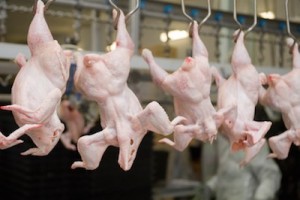The advocacy organization Food & Water Watch has released a statement saying that privatized meat inspections jeopardize food safety. Food Poisoning Bulletin has been telling you about the government’s effort to turn inspections of meat plants over to corporations for years. This analysis, conducted on inspection documents and noncompliance reports obtained through the Freedom of Information Act reveals defects in HIMP, USDA’s HACCP-based Inspection Models Project.
 Wenonah Hauter, executive director of Food & Water Watch, said in a statement, “Based on the data coming out of the plants where this privatized inspection scheme is already in place, it is unacceptable for USDA to try to expand this program to more plants.” The pilot project has been running in 24 slaughter facilities since 1998 and the government wants to expand the project to all poultry slaughter plants.
Wenonah Hauter, executive director of Food & Water Watch, said in a statement, “Based on the data coming out of the plants where this privatized inspection scheme is already in place, it is unacceptable for USDA to try to expand this program to more plants.” The pilot project has been running in 24 slaughter facilities since 1998 and the government wants to expand the project to all poultry slaughter plants.
This step will eliminate more than 800 inspector positions. The poultry industry will save more than $250 million, since they can increase line production speeds to 175 birds a minute, which gives inspectors 1/3 of a second to look at every carcass for defects and possible food safety issues. Even more alarming, some plants have been granted line speed waivers, and have operated these lines at 200 birds per minute. The USDA sets the standard for line speeds at 35 birds per minute.
The project also lets slaughter houses sample just 20 to 80 birds per line in an eight hour shift; thousands of birds are processed on any line in a shift so thousands of birds fly through the lines basically uninspected. The defects that are considered serious enough to remove a carcass from processing include two food safety issues; the other five are “Other Consumer Protection” issues.
The report states that company employees miss many defects in poultry carcasses. The average error rate in “Other Consumer Protection 4” defects, which include feathers, lungs, oil glands, trachea, and bile on the carcass was 64% in chicken facilities and 87% in turkey slaughter facilities. There is no consistency in the number of defects missed from plant to plant across the industry.
In fact, the “overwhelming number” of non-compliance records filed for the 14 plants was for fecal contamination on the carcasses. Ninety-percent of non-compliance reports filed from March to August 2011 were for visible feces on the birds. Feces carry pathogenic bacteria, such as Salmonella and E. coli.
Hauter added, “USDA inspectors receive extensive training to protect public health in poultry facilities, but there is no requirement for company employees to receive training before they assume these inspection responsibilities in the proposed privatized inspection program. USDA’s proposal to shift this public health responsibility to company employees is a budget-cutting maneuver that puts consumers at risk.”
Large food poisoning outbreaks linked to poultry products in the past few years include the huge Foster Farms Salmonella outbreak in 2014, which sickened at least 634 people in 29 states and hospitalized 38% of them. The seven Salmonella strains in that outbreak were resistant to multiple antibiotics. And the ongoing Salmonella outbreak linked to recalled Aspen Foods frozen, breaded, stuffed chicken breasts has sickened people in two separate outbreaks.




